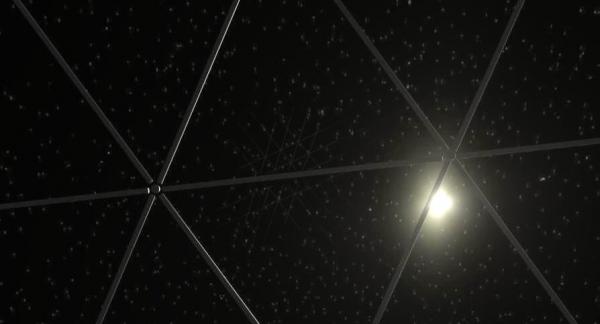BY LETTER
Buckyhabs and Kepler Habitats
Technology > Technology Levels > High Tech / Hitech
Technology > Application > Infrastructure
Technology > Application > Megascale Engineering
Technology > Application > Infrastructure
Technology > Application > Megascale Engineering
Clusters of habitats arranged in polyhedral or geodesic arrays |
 Image from Steve Bowers |
More often than not this active stabilization is in the form of a counter-rotating mass the habitat is some how linked to. In the early "hatbox" design the counter-rotating mass was an external sleeve of radiation shielding. In the classic O'Neill colony the cylinders are twinned, laid side-by-side, and connected at their hubs through long compression/tension spars. A McKendree cylinder has a radius so large that most of its interior is in a vacuum so a second, smaller, cylindrical habitat can be counter-rotated within it. This kind of stablization allows cylinders to be up to five times as long as their diameter. In the extreme example of cylindrical length, a topopolis, the habitat becomes its own counter-rotating mass when it loops around a star to link its two ends to each other. A topopolis can even be looped around the star several times in a configuration known as a torus knot.
Cylinders connected into hoops are quite common; two well-known examples are Evermore and the Rungworld. These rely on dynamic rings to avoid collapse. But in other designs the cylinders themselves are used as structural members.
If you have three or more cylinders they can be linked hub to hub, through special jointed sections called knuckles, to form a small ring as a triangle, a square, etc. Knuckles can be built to hold more than two hubs and this leads to habitat clusters configured like polyhedral space frames, with the cylinders placed as the straight edges. For example, six cylinders form a tetrahedron, thirty can be used to build a dodecahedron and ninety can be formed into a buckyball-like megastructure. Linking cylinders in three dimensions like this has three advantages. For one, they can be built around a hotpoint with energy collecting panels placed as the faces of the polyhedrons. The second advantage is the cylinders can be even longer. Here the limit to length is not the moment of inertia but the strength of the structure needed to transmit the forces generated to the other cylinders. And third, the megastructures themselves can be made larger just by adding greater numbers of smaller components.
The classing of these habitat clusters into buckyhabs or Kepler habs is flexible. The Old Earth German mathematician Johannes Kepler formulated a hypothesis of planetary spheres in terms of the five platonic solids. Because of this, and the fame of the Kepleria dyson structure, any polyhedral configuration may be called a Kepler hab by association, even if it is not based on (nor even derived from) one of those five polyhedrons. In many buckyhabs, by contrast, knuckles and cylinders in these habitats either copy the arrangements of the atoms and bonds found in the molecules known as "fullerenes" (buckyballs and bucktubes) or they copy the arrangements of the connectors and spars found in the geodesic spheres popularized by the Old Earth thinker - R. Buckminster Fuller. However, the term "buckyhab" may also be used to refer to any polyhedral linkage of habitats.
The largest buckyhab to date is Buckminster dyson sphere under construction at YTS-7742-6691-E45 in the MPA. It is a triangulated framework six AU across, reinforced by dynamic compression members. Each strut of the frame is actually a 100,000 km long McKendree cylinder that rotates around the dynamic compression member at its axis. While the structure of this dyson is simple and repetitive it does provide real creativity in ecopoesis; when it is completed there will be nearly six hundred million of these self-contained, planetary scale habitats available for experiments in biospheric design.
Related Articles
Appears in Topics
Development Notes
Text by AI Vin
Initially published on 03 November 2010.
Title and terminology adjustments, July 2024, ProxCenBound
Initially published on 03 November 2010.
Title and terminology adjustments, July 2024, ProxCenBound






